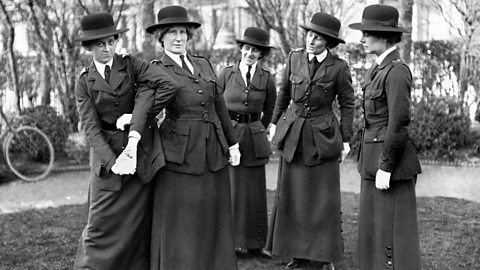During the 1st World War many women worked on factory production lines assembling planes, tanks and making ammunition for the war effort.
Crowded together in factories, they discovered a new sense of team spirit and it worked as well on the football pitch as it did on the shop floor.
Women’s football was a novelty, rather shocking…
Teams from the shipyards, engineering works and munitions donned mobcaps and shorts to general amazement. Even more than today, many thought: women – playing football?
Many men were keen to point out why the women should not play. The British Medical Journal was worried about, "The danger to women’s organs which the common experience of women had in every way led them to protect."
But in 1915 the men’s professional game was suspended – the trenches had taken both players and officials and the women’s game flowered.
Most of the women’s games were to raise funds for soldiers and their families, a Christmas Day Match in 1917 watched by a crowd of 10,000 raised 600 pounds for wounded soldiers, the equivalent of more than 25,000 pounds today.
One occasion, the women played men who had their hands tied behind their backs, as a handicap – the keeper was allowed one hand free. But usually the women’s teams played each other, sometimes with bruising intensity.
The most successful team, in the North East of England, was Blyth Spartans Munitions Girls.
In their first game, 17-year-old centre-forward Bella Reay scored six goals.
Bella was the daughter of a local pitman. She quickly became the star of the team, scoring 133 goals in one season. And Blyth Spartans Munitions Girls remained unbeaten for the two years they were together.
Yvonne:
She worked in the munitions factory, you know, when she was seventeen. And they decided then that they wanted to do something more for the war effort. All of the games that they ever did were all for the wounded soldiers – all the money they ever made, it was all done for charity.
Kate:
Did lots of people come to see them?
Yvonne:
Yes, she played anywhere from crowds of a thousand, up to twenty thousand people.
Kate:
When your grandmother talked to you about football, what did she say?
Yvonne:
Just how good she was. That was the main thing, you know. She said, I was good, but I knew I was good. We will never forget her saying that to us, oh I knew I was good.
Kate:
She played in the Munition Girls Cup Final, didn’t she?
Yvonne:
Yes she did, yes.
Kate:
That must have been a big match.
Yvonne:
Yes, it was. That was when she got her gold medal. Which, would you like to have a look at the medal she got?
Kate:
Fantastic!
Yvonne:
Beautiful medal, it is.
Kate:
How did she do in the final?
Yvonne:
Very well. She was, I think she was the best goal scorer in the final.
Kate:
People are surprised now to hear that girls played football at that time. What do you think of that?
Yvonne:
Well when because when they go on about it, I say, well, my grandma played nearly a hundred years ago, and we’re very very proud that we are part of history, really, you know because she was very very well-known in her time. Everybody knew her – “Woah, Bella”, that was what they used to shout – “Away, Bella!” You know that that’s the thing, and it’s lovely really to think that we are part of a little bit of history.
Kate:
By 1921 the Football Association had had enough and it banned the women from playing on their grounds saying, the game of football is quite unsuitable for females and ought not to be encouraged. Women’s football like so much else was only tolerable for the duration of the war.
Video summary
Kate Adie narrates an in depth look into the start of women’s football.
With archive and contemporary footage juxtaposed, we see how women’s football became a part of society, and in turn, the war effort; many of the games raising thousands of pounds for the soldiers and war charities.
The Blyth Spartans team is a particular focus and their star player: Bella Reay; who was recognised for her sporting skill with a medal.
The differences in the ways women were treated compared to men are also considered.
Teacher Notes
Pupils can highlight and discuss how far social attitudes towards class remained during the war, despite the changes in gender politics.
This might be part of a wider investigation into the social impact of World War One.
This clip will be relevant for teaching History at KS3, KS4/GCSE, in England and Wales and Northern Ireland.
Also at Third Level, Fourth Level, National 4 and National 5 in Scotland.
This topic appears in OCR, Edexcel, AQA, WJEC, CCEA GCSE and SQA.
How the suffragette movement changed at the start of WW1. video
Kate Adie examines how the suffragette movement shifted focus at the outbreak of World War One.
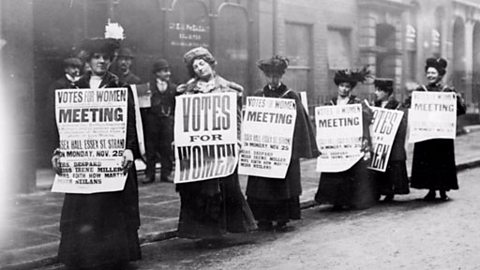
How the first women gained the right to vote in 1918. video
Kate Adie discovers how the Representation Act gave some women the right to vote at the end of Word War One.
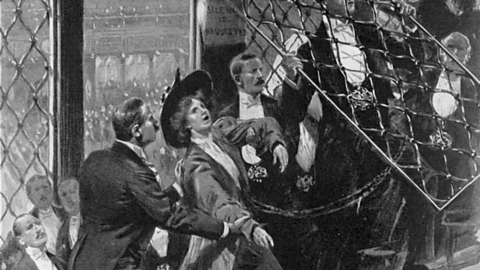
How women joined the war effort in World War One. video
Kate Adie explores how women of all classes joined the workforce overseas and on the Home Front.
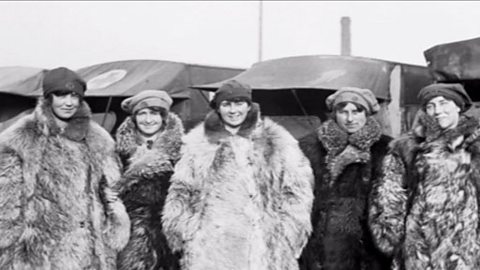
Women in medicine and health in World War One. video
Kate Adie explains how women staffed the medical services and broke down social attitudes during WW1.
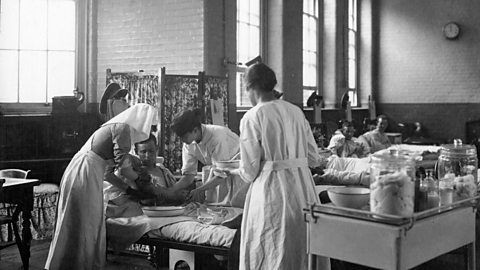
The rise of the girls' night and the first women's police force in WW1. video
Kate Adie explains the story of Margaret Damer Dawson, the Women's Police Service and the rise of the girls' night out in WW1.
